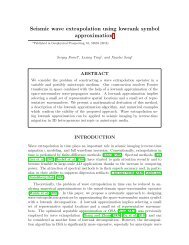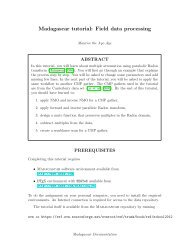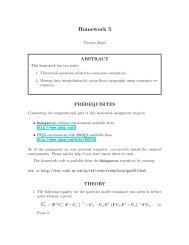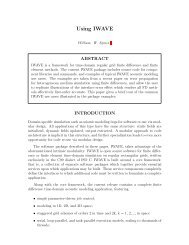Applications of plane-wave destruction filtersa
Applications of plane-wave destruction filtersa
Applications of plane-wave destruction filtersa
You also want an ePaper? Increase the reach of your titles
YUMPU automatically turns print PDFs into web optimized ePapers that Google loves.
Fomel 6 Plane-<strong>wave</strong> destructors<br />
with respect to σ. After system (14) is solved, the initial slope σ 0 is updated by<br />
adding ∆σ to it, and one can solve the linear problem again. Depending on the<br />
starting solution, the method may require several non-linear iterations to achieve an<br />
acceptable convergence.<br />
The slope σ in equation (14) does not have to be constant. We can consider it<br />
as varying in both time and space coordinates. This eliminates the need for local<br />
windows but may lead to undesirably rough (oscillatory) local slope estimates. Moreover,<br />
the solution will be undefined in regions <strong>of</strong> unknown or constant data, because<br />
for these regions the local slope is not constrained. Both these problems are solved<br />
by adding a regularization (styling) goal to system (14). The additional goal takes<br />
the form<br />
ɛD ∆σ ≈ 0 , (15)<br />
where D is an appropriate roughening operator and ɛ is a scaling coefficient. For<br />
simplicity, I chose D to be the gradient operator. More efficient and sophisticated<br />
helical preconditioning techniques are available (Claerbout, 1998; Fomel, 2001; Fomel<br />
and Claerbout, 2002).<br />
In theory, estimating two different slopes σ 1 and σ 2 from the available data is<br />
only marginally more complicated than estimating a single slope. The convolution<br />
operator becomes a cascade <strong>of</strong> C(σ 1 ) and C(σ 2 ), and the linearization yields<br />
C ′ (σ 1 ) C(σ 2 ) ∆σ 1 d + C(σ 1 ) C ′ (σ 2 ) ∆σ 2 d + C(σ 1 ) C(σ 2 ) d ≈ 0 . (16)<br />
The regularization condition should now be applied to both ∆σ 1 and ∆σ 2 :<br />
ɛD ∆σ 1 ≈ 0 ; (17)<br />
ɛD ∆σ 2 ≈ 0 . (18)<br />
The solution will obviously depend on the initial values <strong>of</strong> σ 1 and σ 2 , which should<br />
not be equal to each other. System (16) is generally underdetermined, because it<br />
contains twice as many estimated parameters as equations: The number <strong>of</strong> equations<br />
corresponds to the grid size <strong>of</strong> the data d, while characterizing variable slopes σ 1 and<br />
σ 2 on the same grid involves two gridded functions. However, an appropriate choice<br />
<strong>of</strong> the starting solution and the additional regularization (17-18) allow us to arrive at<br />
a practical solution.<br />
The application examples <strong>of</strong> the next section demonstrate that when the system<br />
<strong>of</strong> equations (14-15) or (16-18) are optimized in the least-squares sense in a cycle <strong>of</strong><br />
several linearization iterations, it leads to smooth and reliable slope estimates. The<br />
regularization conditions (15) and (17-18) assure a smooth extrapolation <strong>of</strong> the slope<br />
to the regions <strong>of</strong> unknown or constant data.<br />
APPLICATION EXAMPLES<br />
In this section, I examine the performance <strong>of</strong> the finite-difference <strong>plane</strong>-<strong>destruction</strong><br />
filters on several test applications. The general framework for applying these filters<br />
SEP–105











